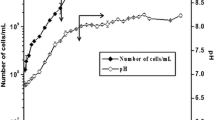Abstract
We have isolated a Pseudomonas aeruginosa strain designated CHL004 which is able to remove lead from solidified media and soil. The process for testing removal was generally the same for all experiments. A piece of sterile filter paper was placed on the surface of a plate containing solidified media and lead carbonate or lead contaminated soil and incubated at 29 °C for 30 days. Lead was removed from yeast malt plates but generally not from R2A plates. Dextrose was shown to be a critical component in the YM; without it almost no lead was removed. Sucrose, maltose and lactose could not be substituted for the dextrose although these carbon sources allowed for survival and growth of the isolate. In order to study the initial kinetics of lead uptake, lead nitrate was used in an aqueous environment. The rate of uptake of lead nitrate by CHL004 was very rapid initially then decreased greatly. Sodium azide treated cells did not remove lead. The removal of lead from an urban soil was affected by the pH of the soil. The pH of the soil in YM was 6.9 and 3.3% of the total lead in the soil was removed. When the pH was adjusted to a pH of 5, 8% of the total lead was removed but at a pH of 6, 6.4% was removed.
Similar content being viewed by others
References
Al-Abed, S. R., D'Amore, J. J., and Ryan, J. A.: 1994, Environmental Science and Technology (submitted).
Allison, M.: 1992, Harvard Health Letter 17, 6.
Bornschein, R., Succop, P., Dietrich, K., Clark, C., Que Hee, S., and Hammond, P.: 1985, Envir Res. 38, 108.
Ehrlich, H., and Holmes, D.: 1986, Biotechnology for the Mining, Metal Refining, and Fossil Fuel Processing Industries, John Wiley and Sons, New York, p. 386.
Fourest, E., and Roux, J-C.: 1992, Appl. Microbiol. Biotech. 37, 399.
Gadd, G.: 1988, Biotechnology, Vol. 6b, VCH, Weinheim, p. 401.
Galun, M., Galun, E., Siegel, B., Keller, P., Lehr, H., and Siegel, S.: 1987, Water Air and Soil Pollut. 33, 359.
Hollo, J., Toth, J., Tengerdy, R., and Johnson, J.: 1979, Immobilized Microbial Cells, ACS Symposium Series 106, American Chemical Society, Washington, DC.
Khummongkol, D., Canterford, G., and Fryer, C.: 1982, Biotech. Bioeng. 24, 2643.
Lanouette, K.: 1977, Chem. Engineer. 34, 73.
Mielke, H., Anderson, J., Berry, K., Mielke, P., Chaney, R., and Leech, M.: 1983, Amer J. Public Health 73, 1366.
Norris, P, and Kelly, D.: 1979, Dev. Ind. Microbiol. 20, 299.
Premuzic, E., and Lin, M.: 1989, Heavy Metals in the Environment, Vol. 2, CEP Consultants LTD, Edinburgh, p. 203.
Strandberg, G., Shumate II, S., and Parrott Jr., J.: 1981, Appl. Environ. Micro. 41, 237.
Tsezos, M.: 1985, Can. Metal Quar 24, 141.
Author information
Authors and Affiliations
Rights and permissions
About this article
Cite this article
Vesper, S.J., Donovan-Brand, R., Paris, K.P. et al. Microbial removal of lead from solid media and soil. Water Air Soil Pollut 86, 207–219 (1996). https://doi.org/10.1007/BF00279157
Received:
Accepted:
Issue Date:
DOI: https://doi.org/10.1007/BF00279157




